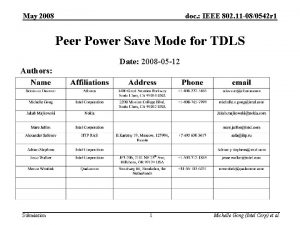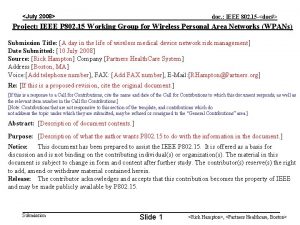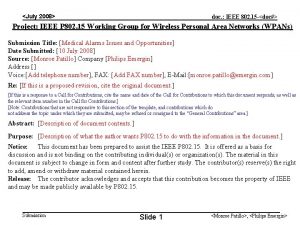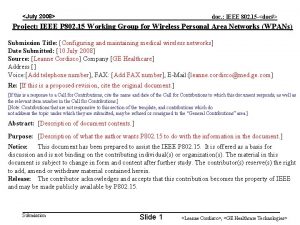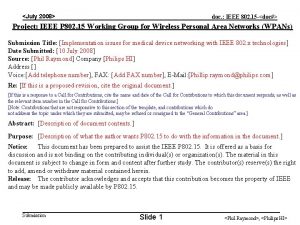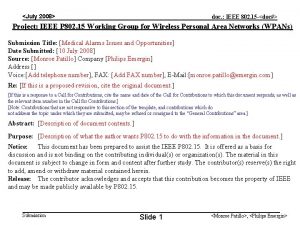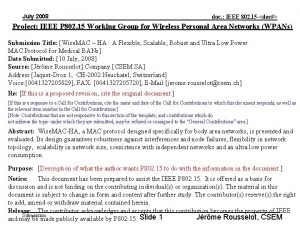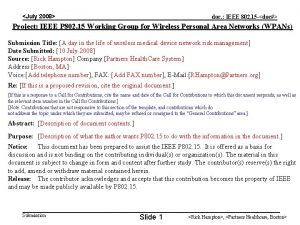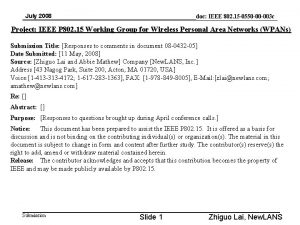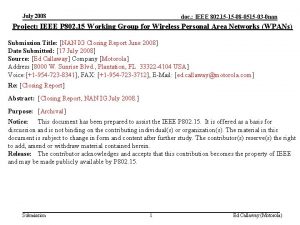July 2008 doc IEEE 802 11 080542 r













- Slides: 13

July 2008 doc. : IEEE 802. 11 -08/0542 r 3 Peer Power Save Mode for TDLS Authors: Submission Date: 2008 -07 -15 1 Michelle Gong (Intel Corp) et al.

July 2008 doc. : IEEE 802. 11 -08/0542 r 3 In some usage scenarios, both peer STAs may want to go into PS mode over a direct link • For instance, when a laptop is communicating with a handheld device over a direct link, both want to save power while still maintaining the direct link • The existing asymmetric peer PSM mechanism as defined in 11 z D 1. 0 does not address this usage scenario Submission 2 Michelle Gong (Intel Corp) et al.

July 2008 doc. : IEEE 802. 11 -08/0542 r 3 To support the peer PSM mode, two peer STAs exchange Request and Response frames AP QSTA 1 changes to Power Save Mode 3 5 QSTA 1 4 QSTA 1 wakes up at scheduled time 1 2 Submission Buffered DATA frame (EOSP is set to 1) Encapsulated DATA frame (TDLS PSM Switch Request) QSTA 2 changes to Power Save Mode 3 QSTA 2 4 QSTA 2 wakes up at scheduled time Encapsulated DATA frame (TDLS PSM Switch Response) 3 Michelle Gong (Intel Corp) et al.

July 2008 doc. : IEEE 802. 11 -08/0542 r 3 Format of the TDLS PSM Request frame Order Information Notes 1 Dialog Token The Dialog Token is set to a non-zero value that is unique among TDLS Peer PSM Request frames for which a corresponding TDLS Switch Response frame has not been received. 2 Link Identifier The link identifier is specified in section 7. 3. 2. z 1 3 Wakeup Schedule IE 4 Vendor Specific Submission The Wakeup Schedule IE describes a schedule for the wakeup time One or more vendor-specific information elements may be in this frame. 4 Michelle Gong (Intel Corp) et al.

July 2008 doc. : IEEE 802. 11 -08/0542 r 3 Format of the TDLS PSM Response frame Ord er Information 1 Dialog Token 2 Status Code The Status code identifies the result of the response as defined in Table 7 -23. 3 Link Identifier The link identifier is specified in section 7. 3. 2. z 1 4 Wakeup Schedule IE The Wakeup Schedule IE describes a schedule for the wakeup time 5 Vendor Specific One or more vendor-specific information elements may be in this frame. Submission Notes The Dialog Token is set to the non-zero value contained in the TDLS Peer PSM Request frames to identify the request/response transaction 5 Michelle Gong (Intel Corp) et al.

July 2008 doc. : IEEE 802. 11 -08/0542 r 3 A STA may reject a wakeup schedule for various reasons Status code Submission Meaning <ANA> Wakeup schedule rejected but alternative schedule provided <ANA> Wakeup schedule rejected because not going into power save <ANA> Wakeup schedule rejected for unspecified reason 6 Michelle Gong (Intel Corp) et al.

July 2008 doc. : IEEE 802. 11 -08/0542 r 3 The Wakeup Schedule IE has the following fields Octets Element ID Length Start Time Interval Min Duration Idle Count 1 1 8 4 4 2 • The Start Time field is 8 octets and indicates the anticipated time, expressed in microseconds, when both STAs need to wakeup – It represents the TSF timer value at the start of the first wakeup period (WP) – Start. Time can be set to a beacon TBTT plus an offset • The Interval field indicates the time, expressed in microseconds, between two successive wakeup periods • The Idle Count field indicates how many consecutively empty wakeup periods a peer STA would allow before it suspends the direct link Submission 7 Michelle Gong (Intel Corp) et al.

July 2008 doc. : IEEE 802. 11 -08/0542 r 3 Minimum Duration is introduced so that two STAs have time to access the channel • Both peer STAs wake up at or before the scheduled wakeup period and stay awake for Minimum Duration after the beginning of the wakeup period • A bi-directional peer service period begins after an acknowledged frame exchange • A STA shall remain awake until it receives an MPDU with EOSP bit set to 1 • The peer service period is terminated when both peer STAs transmitted an MPDU with the EOSP bit set • The peer STAs may go back to doze state when data exchanges complete successfully before the Minimum Duration time Minimum duration Interval Submission 8 Michelle Gong (Intel Corp) et al.

July 2008 doc. : IEEE 802. 11 -08/0542 r 3 Peer STAs wake up at or before the start of a wakeup period STA B STA A TDLS PSM Switch Request TDLS PSM Switch Response Minimum wakeup period Buffered DATA (EOSP=0) Buffered DATA (EOSP=1) A peer service period begins after an acknowledged frame exchange between the peer STAs The scenario when the “More data” bit in ACK is supported is in the backup slides Submission 9 Michelle Gong (Intel Corp) et al.

July 2008 doc. : IEEE 802. 11 -08/0542 r 3 A service period between two STAs in PS mode may be initiated within the minimum wakeup duration • If STA A has buffered traffic for STA B, STA A can directly send buffered data frames to STA B within the minimum duration – STA A sets the EOSP bit of all its data frames to 0, until it does not intend to transmit more frames to STA B. STA A sets the EOSP bit in the last data frame to 1 • STA B can transmit its frames to STA A while it’s receiving STA A’s packets • After a service period is initiated, both STA A and STA B shall remain awake until one of the following conditions are met – If “More Data” bit in ACK is supported: Peer STAs may go back to doze state after one acknowledged frame exchange with the EOSP bit in an MPDU set to 1 and the More Data bit in the ACK frame set to 0 – If “More Data” bit in ACK is not supported: Peer STAs may go back to doze state after one acknowledged frame exchange in each direction with the EOSP bit in the MPDU set to 1 Submission 10 Michelle Gong (Intel Corp) et al.

July 2008 doc. : IEEE 802. 11 -08/0542 r 3 In summary, this peer PSM scheme is flexible and addresses a broader range of use cases • The peer PSM allows one or both STAs to go into power save mode while still maintaining the peer link • The procedure is as follows: – Two STAs negotiate a wakeup schedule – STAs wakeup at or before the start of a wakeup period and start data packet exchange – A peer service period is initiated by an acknowledged frame exchange between the peer STAs – The peer service period is terminated 1) when both peer STAs transmitted an MPDU with the EOSP bit set to 1 or 2) through one acknowledged frame exchange with the EOSP bit in the MPDU set to 1 and “More data” bit in the ACK set to 0 – Peer STAs may stay in doze state after “Idle Count” number of consecutive empty wakeup periods • Detailed information can be found in 11 -08/0668 r 8 Submission 11 Michelle Gong (Intel Corp) et al.

July 2008 doc. : IEEE 802. 11 -08/0542 r 3 Backup Submission 12 Michelle Gong (Intel Corp) et al.

July 2008 doc. : IEEE 802. 11 -08/0542 r 3 Utilize the More Data bit in the ACK frame QSTA 1 Minimum Duration QSTA 2 Buffered DATA (EOSP=0) ACK (More data=1) Buffered DATA (EOSP=1) ACK (More data=1) Remain awake Buffered DATA (EOSP=0) ACK (More data=0) Buffered DATA (EOSP=1) ACK (More data=0) Go back to sleep The shortest frame exchange during one wakeup period (Data(EOSP=1) / SIFS / ACK (More. Data=0) Submission 13 Michelle Gong (Intel Corp) et al.














